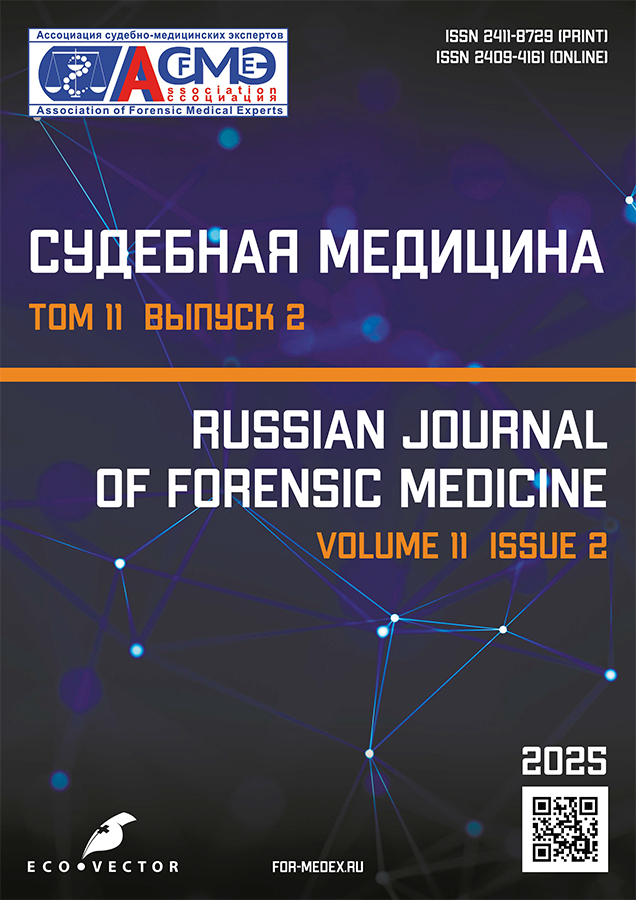Russian Journal of Forensic Medicine
Рецензируемый научно-практический медицинский журнал для специалистов в области судебно-медицинской экспертизы.
Главный редактор
- Владимир Александрович Клевно, д.м.н., профессор
ORCID: 0000-0001-5693-4054
Учредители журнала
- Ассоциация судебно-медицинских экспертов (http://asme.nichost.ru)
- Издательство Эко-Вектор (https://eco-vector.com)
О журнале
Журнал публикует статьи по научным направлениям: судебно-медицинская патология и гистохимия, химия, биохимия и токсикология, биология, серология, одонтология, психиатрия, антропология, цифровая криминалистика, физические науки, огнестрельное оружие и экспертиза документов, а также исследования, где наука и медицина взаимодействуют с законом. Журнал публикует оригинальные исследования, обзоры, тематические отчеты, комментарии, письма в редакцию, клинические и лабораторные наблюдения российских и зарубежных авторов на темы, релевантные аудитории в странах СНГ и всего мира. Подробнее о целях и задачах можно прочесть здесь.
Периодичность выхода публикаций
- Ежеквартально в составе очередных выпусков (4 раза в год).
- Непрерывно на сайте по мере одобрения каждой статьи (Online First).
Языки публикации
- английский
- русский
- китайский
Открытый доступ
- Статьи публикуются в сети Интернет в открытом доступе (Gold Open Access) и распространяются на условиях открытой лицензии Creative Commons Attribution-NonCommercial-NoDerivates 4.0 International (CC BY-NC-ND 4.0).
Журнал входит в Перечень рецензируемых научных изданий, рекомендованных ВАК РФ для опубликования основных результатов диссертационных исследований на соискание ученых степеней доктора и кандидата наук.
Плата за публикацию
- Рассмотрение рукописи от авторских коллективов для публикации в журнале осуществляется на бесплатной основе (NO Article Submission Charge).
- Публикация одобренных редакционной коллегией статей осуществляется на платной основе (Article Processing Charge / Article Publication Charge). Плата за публикацию взимается издательством только после одобрения рукописи редакционной коллегией, и не влияет на принятие решения редакционной коллегией, не влияет на качество отбора рукописей и уровень требовательности рецензентов и редакторов к авторам и произведениям.
- Плата за публикацию может быть снижена или отменена по ходатайству авторского коллектива. Более подробная информация в разделе "Правила для авторов"
最新一期
卷 11, 编号 2 (2025)
- 年: 2025
- 文章: 10
- URL: https://journals.rcsi.science/2411-8729/issue/view/20976
- DOI: https://doi.org/10.17816/2411-8729-2025-11-2
完整期次
原创研究
死产案件中开展多专家委员会法医鉴定时组织形态学研究的作用
摘要
论证:俄罗斯联邦侦查机关在开展与产科医疗救治质量不佳相关的核查措施和刑事案件侦查时,其程序方法中包括委托实施由多名专家共同进行的委员会法医鉴定。对归档尸体解剖材料和胎盘实施法医组织学检查,是根据案件材料在胎儿宫内死亡案件中开展多专家委员会法医鉴定的重要环节。
目的:分析死产案件中的多专家委员会法医鉴定,并根据现代科学观点明确对归档尸检材料和胎盘进行法医组织学检查的必要性。
方法:在俄罗斯Stavropol Krai “Territorial Bureau of Forensic Medical Examination”复杂鉴定科的档案库中,开展了一项单中心、横断面、抽样的观察性研究。纳入标准为:在产前期和产时胎儿宫内死亡案件中开展的多专家委员会法医鉴定。
结果:纳入研究的胎儿宫内死亡案件多专家委员会法医鉴定共有68例(n=68),时间范围为2015年1月1日至2022年12月31日。其中,79.4%(n=54)由俄罗斯联邦侦查委员会侦查员委托,16.2%(n=11)由俄罗斯联邦内务部所属部门的侦查员/调查员/刑警委托,4.4%(n=3)由法官委托。在86.7%的案件中,此类鉴定是在核查材料框架内开展的。死产原因中,57.4%(n=39)为产前期胎儿死亡,39.73%(n=27)为产时胎儿死亡,2.9%(n=2)为先天性发育异常。在胎儿宫内死亡案件的多专家委员会法医鉴定中,97.1%(n=66)的病例中,法医组织学专家对尸检材料和胎盘进行了法医组织学检查。
结论:分析表明,39.1%的产科—妇科方向多专家委员会法医鉴定与死产相关。为提高此类鉴定的质量,有必要对尸检材料和胎盘进行法医组织学检查。完善死产案件中多专家委员会法医鉴定的方法学,是法医专家、病理解剖学家、产科医生及新生儿科医生跨学科合作的一项重要任务。
 112-122
112-122


A pilot study on forensic odontologists’ practices in the registration and analysis of dog bite marks in humans
摘要
论证:犬咬痕迹和损伤是一个严重的公共卫生问题,严重影响着经济和生活质量。
目的:探讨全球法医牙医最常见的犬咬病例记录和痕迹分析做法。
方法:本研究纳入了22名法医牙医,他们回答了关于其在犬咬痕迹评估领域的实践经验的问题。受访者被问及他们记录犬咬痕迹、检查疑似实施袭击的动物、收集生物证据以及遵守不同国家法律法规的方法。
结果:研究样本中的男性和女性参与者人数相等。平均年龄为47.3±13.6岁。大多数(63.6%) 是持有执照的法医牙医,另有9.1%正在攻读学位。超过一半的参与者(54.5%) 拥有超过15年的专科经验。约三分之一的参与者(36.4%)在实践中遇到过犬咬案件。大多数受访者(95.4%)认识到拍照记录咬痕的必要性;然而,不同职业阶段的专家对此的看法在统计学上存在显著差异(p=0.008)。为了对咬痕部位进行取模,受访者通常使用藻酸盐、硅酮和其他弹性印模材料(50.0%),也应用数字摄影测量方法(36.4%)。尽管摄影测量技术的应用有限,但68.2%的法医牙医推荐使用这种方法。此外,72.8%的受访者指出了获取DNA样本和微生物群分析样本的重要性。绝大多数受访者(77.3%)承认,他们不知道存在用于对犬类进行法医分析以便通过咬痕识别其身份的专用工具包。此外,大多数受访者(68.2%)支持实施标准化算法,以便更准确、更一致地记录犬类咬痕。
结论:根据研究结果,专家们就法医调查的关键阶段达成了共识,包括对咬痕进行拍照记录和对犬只进行检查。然而,获取DNA样本的要求和法律法规可能因司法管辖区而异。为了提高这一重要法医学领域的法医检验质量和可靠性,有必要制定统一的规程并开展进一步的研究。
 123-136
123-136


技术报告
关于选择用于热力学方法推断死后间隔时间的温度测量仪器精度问题
摘要
论证: 尽可能准确地确定人的死后间隔时间对于客观调查危害生命的犯罪案件具有重要意义。众所周知,任何基于计算的方法都可能受到参数测量误差的影响,而仪器误差是其中的重要来源。然而,在热测法推断死后间隔时间的过程中,尚未确定何种温度测量精度在法医学鉴定实践中可视为令人满意。
目的:基于分析尸体及环境温度测量精度对计算推断死后间隔时间误差的影响,提出关于选择测温仪器的实用建议,供法医学尸检工作参考。
方法:采用C. Henssge等人提出的现象学数学模型,模拟在不同诊断区域(大脑、肝脏、直肠)及两种环境温度0°C和20°C条件下的尸体温度变化过程。在上述条件下,计算该方法在测温精度为1°C、0.1°C和0.01°C时的仪器误差值。所得误差以绝对值和相对值(%)表示,后者为误差值与其对应的死后间隔时间的比值。
结果:结果显示,尸体冷却早期及尸体温度趋近环境温度阶段的相对误差最大。在所有模拟条件下,使用测温精度为1°C的温度计时,相对误差均超过死后间隔时间估值的15%。 此外,使用测温误差为0.1°C和0.01°C的仪器,可在整个模拟时间段(2–24小时)内将相对仪器误差控制在不超过5%。
结论:从医学与生物学研究的标准要求来看,只有在尸体与环境温度的测量精度达到0.1°C或0.01°C时,才有可能获得令人满意的推断结果。为便于实际应用,我们将死后间隔时间仪器误差的计算算法实现为Microsoft Excel电子表格形式。
 137-144
137-144


法医数字病理学中的组织立体几何在线分析
摘要
论证:法医数字病理学的重要组成部分是对组织学、组织化学和免疫组织化学切片图像的定量分析。然而,商业分析软件获取受限,制约了数字病理学原理及其在俄罗斯法医学鉴定实践中客观组织学诊断方法的推广。本文提出了一种可访问的在线工具,可自动执行组织学和免疫组织化学切片图像及其局部视野图像的组织立体几何分析。
目的:开发一款用于法医数字病理图像组织立体几何分析的在线工具。
方法:本研究开发了一个兼容Windows、Linux、Android和iOS操作系统的在线应用程序,用于在数字图像中识别具有特定颜色特征的微观对象并进行组织立体几何分析。该程序使用JavaScript编写,基于开源库OpenCV实现。
结果:成功开发了名为Color Histostereometry Calculator的在线应用程序,用于在组织学和免疫组织化学切片的光栅图像中确定具有指定颜色特征的微观对象的体积分数和数量。该工具基于 HSV(Hue, Saturation, Value)颜色模型,支持设置颜色参数范围和最小计量区域大小。采用基于颜色特征而非几何形态识别微观对象的策略,可有效排除图像伪影、分割重叠结构,并针对理想无限薄切片评估形态计量指标,从而消除切片厚度对分析结果的影响。
结论:所开发的在线应用程序可推荐用于法医数字病理学中的组织立体几何分析。
 145-154
145-154


科学评论
机动车在与行人碰撞瞬间行驶速度的鉴定方法:问题的现状综述
摘要
在机动车与行人发生碰撞的道路交通事故中,明确碰撞瞬间的车辆行驶速度对侦查和调查人员依法准确判断驾驶员行为及事故成因具有重要意义。然而,目前适用于鉴定实践的客观测定车辆速度的方法数量有限。
本文基于对俄罗斯及国外文献的综合分析,评述了该问题的研究现状。现有方法根据各自所依据的基本原理进行了分析。研究指出,客观评估车辆在与静止障碍物(如行人)碰撞时的速度是一个复杂任务,需综合运用多种适用性不同的方法。指出有必要在“形态学”诊断领域开展进一步研究,以考虑现代机动车的结构特点,明确与静止行人碰撞的道路交通事故的条件与情形。这不仅有助于实现交通事故调查的全面客观化,也将推动法医学研究的进一步发展。
 155-165
155-165


临床病例报告
利用胎盘组织学石蜡块鉴定代孕母亲与新生儿的遗传亲子关系:系列临床病例
摘要
本文的现实意义在于,辅助生殖技术的广泛可及性以及对此类医疗服务需求的不断增长,同时还需考虑依照俄罗斯联邦法律对其应用进行法律规范的必要性。
本文的撰写缘于俄罗斯联邦侦查委员会侦办的几起刑事案件,在案件中指定进行鉴定,以确定代孕母亲与其所生婴儿之间的遗传亲子关系。文中提出了一种原创性的方法学途径,可有效解决与确定新生儿生物学来源相关的复杂鉴定任务。
在三例鉴定中,使用了胎盘的石蜡包埋块和组织学切片,以及颊黏膜和血液的对比样本。对胎盘组织学切片进行显微镜检查,以确定胎盘各部分的定位。
为鉴定母亲和婴儿在所提供生物学样本中的DNA,并进行比较分析,采用了分子遗传学方法,包括DNA的提取与浓度测定、实时聚合酶链式反应、扩增产物的电泳分离及其后续分析。
研究确定了在组织蜡块中母体部分和胎儿部分的定位,并对其进行了标记。获得了儿童血液样本和代孕母亲颊黏膜样本的基因型,以及已标记对象的遗传图谱。
比较分析结果显示,在所分析的三例中,有一例新生儿血液样本与胎盘的胎儿部分的遗传图谱不相符。在其余两例中,所检遗传谱型完全一致。
该观察结果强调了在鉴定代孕母亲与新生儿亲子关系时使用胎盘组织的重要性,可避免作出错误结论,并使鉴定专家确认特定新生儿确系由该女性在所述分娩中所生。
 166-175
166-175


跌落致伤情形重建:一例法医学案例分析
摘要
仅凭法医学数据确定损伤形成的具体情形在实践中并非总是可行。在某些情况下,借助数学计算对事件动力学的分析,可用于重建机械性损伤的形成条件。
以一名女性从十楼坠落的法医学案例为例,展示在缺乏目击证据的情况下,生物力学(数学)分析在综合动力-运动学法医学鉴定中对跌落致伤情形重建的有效性。
一名年轻女性的尸体被发现于居民楼外的草坪上,其公寓位于第十层,她与男友共同居住。由于存在犯罪嫌疑,俄罗斯联邦侦查委员会对该事件立案调查。男友称其跳楼自尽,但现场调查资料对其供述的真实性提出质疑。为解决死者坠落前是否受到附加“初速度”作用的问题,指定开展由法医专家与工程数学专家共同参与的综合动力-运动学法医学鉴定。构建的数学模型使专家能够判断在无额外外力作用的情况下,即在自发跌落的情形下,身体应首先接触地面的部位。将实际的医学资料与计算结果进行对比后发现,死者坠落前身体确实获得了额外的初始速度。
本案例展示了计算模拟作为数字化工具在法医学中用于客观选择机械性损伤多种可能形成机制之一的应用价值。
 176-184
176-184


在机动车驾驶证吊销案件中运用法医学与毒理学专门知识:组织与方法方面的结论
摘要
本文探讨了在进行醉酒状态医学检查过程中存在的争议性问题。研究材料基于一例实践案例,即在一起行政案件中,法医学与毒理学专家协助审查吊销机动车驾驶证合法性的过程。
详细呈现了事件的时间顺序——从交通巡逻警察拦停一名机动车驾驶员,并当场将其停止驾驶车辆以进行酒精醉酒状态检查开始,直到治安法官作出裁决,该裁决随后由上诉法院维持原判。
通过对该真实案例的分析,表明在化学—毒理学检验中,由于对人体生物液体中精神活性物质的鉴定不可靠而产生的结果解释错误。以在一名职业小客车驾驶员体内检出γ-丁内酯的案例为例,提出了反对采用不可靠化学物质鉴定方法的论据。此外,还发现了临床检验诊断医师培训中的不足,指出了其工作中机械化方法的不可取性,并提出了改进现有不足的途径。
 185-195
185-195


鼠齿作用下软组织死后损伤的形成:病例描述
摘要
由家鼠、野鼠等小型啮齿动物造成的死后损伤,是法医学鉴定中的重要内容。然而,有关此类损伤的系统化资料仍然有限。现有文献多为大鼠致伤的描述,而鼠齿造成的损伤研究相对较少。鉴于此,本文报道了一个病例,展示了鼠齿作用下软组织损伤的特点。
在某村一栋木屋内发现一具男性尸体,其颈部存在损伤。法医学尸检发现,右侧颈部外侧软组织存在缺损,并有迹象表明该损伤为死后形成,系小型啮齿动物(家鼠、野鼠)齿作用所致。在缺损深处发现完整的颈外静脉,并结合该软组织缺损系由小型啮齿动物齿作用死后形成的事实,排除了由锐器造成该损伤的可能性。
相较于大鼠,鼠类的咀嚼器官发育较弱,所致损伤深度有限,主要累及软组织,且多在组织较为坚硬时(如冬季组织变硬)啃咬,并具有特定的形态学特征。此外,鼠齿作用可能显著改变生前损伤的形态。然而,在损伤区域内发现的组织碎片、毛发及动物粪便等,可作为其参与的重要佐证,并需进行详细分析。
 196-203
196-203


Retraction
撤回文章 "在血液和尿液中检测生前摄入含蓖麻毒素的物质的标志物” (doi:
摘要
法医学杂志》编辑部通知读者,《Russian Journal of Forensic Medicine》撤回了以前发表的一篇题为 “在血液和尿液中检测生前摄入含蓖麻毒素的物质的标志物”的文章(Russian Journal of Forensic Medicine。2024;10(4):529–538. doi: 10.17816/fm11244), 涉及文章中介绍的研究过程中发现的违反生物医学伦理的行为。作者无法确认研究方案是否在研究开始前获得了伦理委员会的批准。此外,作者也无法确认参与研究的人员是否仅为自愿(单独或由其法定代表)签署知情同意书参与研究的人员,或书面同意将其医疗数据用于科研目的的人员。
该刊物网站上的电子版原文已被修改(标注为重新标记),期刊编辑部不建议阅读或用于进一步研究。
编辑对发表该研究结果可能造成的后果表示遗憾。
 204-205
204-205









